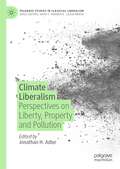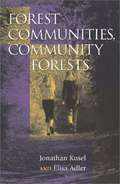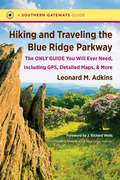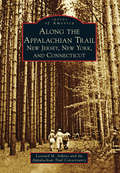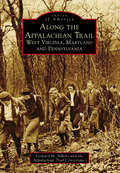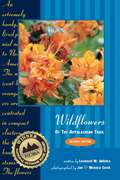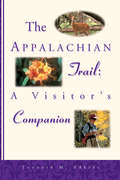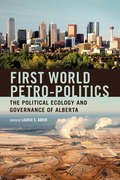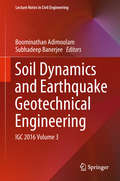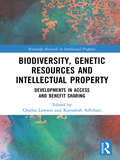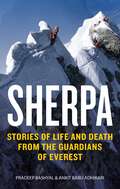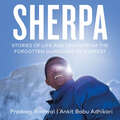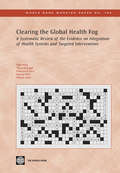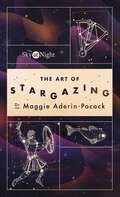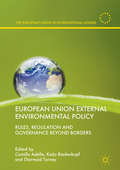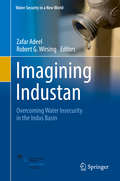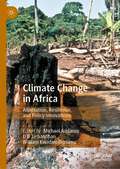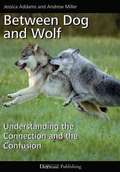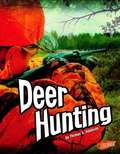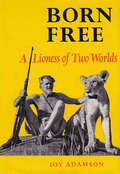- Table View
- List View
Climate Liberalism: Perspectives on Liberty, Property and Pollution (Palgrave Studies in Classical Liberalism)
by Jonathan H. AdlerClimate Liberalism examines the potential and limitations of classical-liberal approaches to pollution control and climate change. Some successful environmental strategies, such as the use of catch-shares for fisheries, instream water rights, and tradable emission permits, draw heavily upon the classical liberal intellectual tradition and its emphasis on property rights and competitive markets. This intellectual tradition has been less helpful, to date, in the development or design of climate change policies. Climate Liberalism aims to help fill the gap in the academic literature examining the extent to which classical-liberal principles, including an emphasis on property rights, decentralized authority and dynamic markets, can inform the debate over climate-change policies. The contributors in this book approach the topic from a range of perspectives and represent multiple academic disciplines. Chapters consider the role of property rights and common-law legal systems in controlling pollution, the extent to which competitive markets backed by legal rules encourage risk minimization and adaptation, and how to identify the sorts of policy interventions that may help address climate change in ways that are consistent with liberal values.
Urban Ecosystems
by Frederick R. Adler Colby J. TannerAs humans have come to dominate the earth, the ideal of studying and teaching ecology in pristine ecosystems has become impossible to achieve. Our planet is now a mosaic of ecosystems ranging from the relatively undisturbed to the completely built, with the majority of people living in urban environments. This accessible introduction to the principles of urban ecology provides students with the tools they need to understand these increasingly important urban ecosystems. It builds upon the themes of habitat modification and resource use to demonstrate how multiple ecological processes interact in cities and how human activity initiates chains of unpredictable unintended ecological consequences. Broad principles are supported throughout by detailed examples from around the world and a comprehensive list of readings from the primary literature. Questions, exercises and laboratories at the end of each chapter encourage discussion, hands-on study, active learning, and engagement with the world outside the classroom window.
Forest Communities, Community Forests
by Elisa Adler Jonathan KuselFinding a Cafeteria of Possibility in an Array of Community Forestry Case Studies
Not Just A Summer Crush
by C. S. Adler[From the front dust jacket flap:] "Awesome. That's the only word Hana can think of to describe her day on the whale-watching boat with her favorite teacher, Mr. Crane... David. Hana was sure she was going to have a miserable summer until she found David Crane sitting on the beach next to her grandmother's cottage on Cape Cod. He has come to the Cape to decide whether he should return to teaching in the fall. And, much to Hana's surprise, the young- teacher actually values her opinion. Twelve-year-old Hana is accustomed to feeling ignored by her family. Even at the beach house, her parents and three older siblings treat Hana like a child. Until, that is, they discover her growing friendship with David Crane, and immediately misinterpret it. How can Hana get them to see why this friendship is so special to her?"
Hiking and Traveling the Blue Ridge Parkway
by Leonard M. Adkins J. Richard WellsThis comprehensive guidebook provides a detailed description of every official trail along the Blue Ridge Parkway. But that's just the beginning: veteran hiker Leonard M. Adkins includes information on every trail that touches the Parkway, including the Appalachian Trail, the Mountains-to-Sea Trail, and other public pathways on national park, state park, national forest, municipal, and private lands. You'll find GPS coordinates for official Parkway trailheads, along with fifty maps and many photographs of what you'll see along the way. Adkins notes each trail's length, difficulty, points of interest, handicap accessibility, and natural features. Far more than a guide to the trails, this book also tells you what to expect at overlooks, as well as where to dine, sleep, and find a restroom, and suggests worthwhile side trips. Elevation change charts for bicyclists, minimum tunnel heights for RVs, camping recommendations, roadside bloom calendars, sightseeing information for nearby towns, and other advice make this the perfect companion for your next Parkway adventure.
Along the Appalachian Trail: New Jersey, New York and Connecticut
by Leonard M. Adkins Appalachian Trail ConservancyCrossing through 14 states from Maine to Georgia, the Appalachian Trail enters New Jersey through the Delaware Water Gap, crosses New York's Hudson River, and rises over Connecticut's Lion's Head. The area is considered by some to be the pathway's birthplace, for in 1923, just two years after Benton MacKaye originally proposed the trail, the first few miles specifically constructed for the Appalachian Trail were built by volunteers in New York's Harriman and Bear Mountain State Parks. These photographs and the corresponding narrative present a historical perspective on what it took to create the trail, including the thousands of volunteers and the arduous tasks they performed, those who lived along the trail before and during its creation, the many people who have enjoyed the trail through the years, and the original routes that are no longer part of the present-day Appalachian Trail.
Along the Appalachian Trail: West Virginia, Maryland, and Pennsylvania
by Leonard M. Adkins Appalachian Trail ConservancyUnlike counterparts on other sections of the 2,180-plus-mile Appalachian Trail who could locate the pathway within national parks and forests, builders of the 270 miles of trail detailed in Along the Appalachian Trail: West Virginia, Maryland, and Pennsylvania did not have vast tracts of federal lands on which to construct the footpath. Yet they succeeded in creating a trail within many of the states' scenic areas. Hundreds of vintage photographs--provided by the Appalachian Trail Conservancy, National Park Service, state archives, and local trail-maintaining clubs--present an illustrated narrative of the Herculean work and dedication it took for volunteers to plan, build, and continue to maintain the trail in these states. Included are the glimpses of American history the trail passes by, the pathway's early (and later) supporters and hikers, and original locations that have been rerouted off of today's trail.
Wildflowers of the Appalachian Trail
by Leonard Adkins Joe Cook Monica CookWildflowers of the Appalachian Trail is the go-to resource for anyone interested in the wildflowers found along the 2,175-mile-long Appalachian National Scenic Trail. Stunning full-page color photos by Joe Cook and Monica Cook accompany the detailed descriptions by author Leonard Adkins. Also included for many of the 94 flowers profiled in the book is the fascinating role the flower has played through history and its value in folkloric as well as modern medicine.
The Appalachian Trail: A Visitor's Companion
by Leonard AdkinsA comprehensive naturalist's guide to the Appalachian Trail, the Visitor's Companion contains all the essential information about the AT - from the trail's fascinating history to detailed information on the geology, trees, flowers, birds, amphibians, reptiles, and mammals of the Appalachian Mountains.
First World Petro-Politics: The Political Ecology and Governance of Alberta
by Laurie AdkinFirst World Petro-Politics examines the vital yet understudied case of a first world petro-state facing related social, ecological, and economic crises in the context of recent critical work on fossil capitalism.A wide-ranging and richly documented study of Alberta's political ecology - the relationship between the province's political and economic institutions and its natural environment - the volume tackles questions about the nature of the political regime, how it has governed, and where its primary fractures have emerged. Its authors examine Alberta's neo-liberal environmental regulation, institutional adaptation to petro-state imperatives, social movement organizing, Indigenous responses to extractive development, media framing of issues, and corporate strategies to secure social license to operate. Importantly, they also discuss policy alternatives for political democratization and for a transition to a low-carbon economy.The volume's conclusions offer a critical examination of petro-state theory, arguing for a comparative and contextual approach to understanding the relationships between dependence on carbon extraction and the nature of political regimes.
Soil Dynamics and Earthquake Geotechnical Engineering: IGC 2016 Volume 3 (Lecture Notes in Civil Engineering #15)
by Boominathan Adimoolam Subhadeep BanerjeeThis book gathers selected proceedings of the annual conference of the Indian Geotechnical Society, and covers various aspects of soil dynamics and earthquake geotechnical engineering. The book includes a wide range of studies on seismic response of dams, foundation-soil systems, natural and man-made slopes, reinforced-earth walls, base isolation systems and so on, especially focusing on the soil dynamics and case studies from the Indian subcontinent. The book also includes chapters addressing related issues such as landslide risk assessments, liquefaction mitigation, dynamic analysis of mechanized tunneling, and advanced seismic soil-structure-interaction analysis. Given its breadth of coverage, the book offers a useful guide for researchers and practicing civil engineers alike.
Biodiversity, Genetic Resources and Intellectual Property: Developments in Access and Benefit Sharing (Routledge Research in Intellectual Property)
by Kamalesh Adhikari Charles LawsonDebates about Access and Benefit Sharing (ABS) have moved on in recent years. An initial focus on the legal obligations established by international agreements like the United Nations Convention on Biological Diversity and the form of obligations for collecting physical biological materials have now moved to a far more complex series of disputes and challenges about the ways ABS should be implemented and enforced: repatriation of resources, technology transfer, traditional knowledge and cultural expressions; open access to information and knowledge, naming conventions, farmers’ rights, new schemes for accessing pandemic viruses and sharing DNA sequences, and so on. Unfortunately, most of this debate is now crystallised into apparently intractable discussions such as implementing the certificates of origin, recognising traditional knowledge and traditional cultural expression as a form of intellectual property, and sovereignty for Indigenous peoples. Not everything in this new marketplace of ABS has been created de novo. Like most new entrants, ABS has disrupted existing legal and governance arrangements. This collection of chapters examines what is new, what has been changed, and what might be changed in response to the growing acceptance and prevalence of ABS of genetic resources. Biodiversity, Genetic Resources and Intellectual Property: Developments in Access and Benefit Sharing of Genetic Resources addresses current issues arising from recent developments in the enduring and topical debates about managing genetic resources through the ABS regime. The book explores key historical, doctrinal, and theoretical issues in the field, at the same time developing new ideas and perspectives around ABS. It shows the latest state of knowledge and will be of interest to researchers, academics, policymakers, and students in the fields of intellectual property, governance, biodiversity and conservation, sustainable development, and agriculture.
Sherpa: Stories of Life and Death from the Forgotten Guardians of Everest
by Ankit Babu Adhikari Pradeep BashyalChanging the narrative of mountaineering books, Sherpa focuses on the people who live and work on the roof of the world.Amid all the foreign adventurers that throng to Nepal to scale the world's highest peaks there exists a small community of mountain people at the foothills of Himalayas. Sherpa tells their story. It's the story of endeavour and survival at the roof of the world. It dives into their culture and tells of their existence at the edge of life and death. Written by Ankit Babu Adhikari - a writer, social science researcher and musician - and Pradeep Bashyal - a journalist with the BBC based in Nepal - Sherpa traces their story pre- and post-mountaineering revolution, their evolution as climbing crusaders with previously unpublished stories from the most notable and incredible Sherpas of the last 50 years.This is the story of the Sherpas.
Sherpa: Stories of Life and Death from the Forgotten Guardians of Everest
by Ankit Babu Adhikari Pradeep Bashyal'Tendi Sherpa had been on the summit of Everest twelve times already before 2019. He was guiding a 60-year-old American climber during one of the busiest periods the mountain had ever seen. On the face of it, his task was simple: to make sure that he and his client did not end up dead on the mountain...'Amid all the foreign adventurers that throng to Nepal to scale the world's highest peaks there exists a small tribe of mountain people at the foothills of Himalayas. Sherpa tells their story. It's the story of endeavour and survival at the roof of the world. The story dives into their culture and tells of their existence at the edge of life and death. It traces their story pre- and post-mountaineering revolution, their evolution as climbing crusaders with never previously published stories from the most notable and incredible Sherpas of the last 50 years.This is the story of the Sherpas.(p) 2022 Octopus Publishing Group
Governing Sustainability
by W. Neil Adger Andrew JordanThe crisis of unsustainability is, above all else, a crisis of governance. The transition to a more sustainable world will inevitably require radical changes in the actions of all governments, and it will call for significant changes to the lifestyles of individuals everywhere. Bringing together some of the world's most highly regarded experts on governance and sustainable development, this book examines these necessary processes and consequences across a range of sectors, regions and other important areas of concern. It reveals that the governance of sustainable development is politically contested, and that it will continue to test existing governance systems to their limits. As an assessment of existing policy practices, it will be of great interest to all those who are preparing themselves - or their organisations - for the sustainability transition.
Clearing the Global Health Fog
by Olusoji Adeyi Kelechi Ohiri Federica V. Secca Rifat Atun Thyra De JonghA longstanding debate on health system organization relates to the benefits of integrating programs that emphasize specific interventions into mainstream health systems to increase access and improve health outcomes. This debate has long been characterized by polarization of views and ideologies, with protagonists for and against integration arguing relative merits of each approach. Recently, the debate has been rekindled due to substantial rises in externally-funded programs for priority health, nutrition, and population (HNP) interventions and an increase in international efforts aimed at health system strengthening. However, all too frequently these arguments have not been based on hard evidence. In this book we present findings of a systematic review that explores a broad range of evidence on: (i) the extent and nature of integration of targeted health programs that emphasize specific interventions into critical health systems functions; (ii) how the integration or non-integration of health programs into critical health systems functions in different contexts have influenced program success; and (iii) how contextual factors have affected the extent to which these programs were integrated into critical health systems functions. The findings provide a new synthesis of evidence to inform the debate on health systems and targeted interventions. In practice a rich mix of solutions exists. While the discussion on the relative merits of integrating health interventions will no doubt continue, discussions should move away from the highly-reductionist approach that has polarized this debate.
The Sky at Night: My Essential Guide to Navigating the Night Sky
by Dr Maggie Aderin-PocockLook up...The Art of Stargazing is the ultimate insider's guide to the night sky in which award-winning space scientist and The Sky at Night presenter Dr Maggie Aderin-Pocock shares her expertise and unique insights into the marvellous world of stars. Take a tour of the 88 constellations and explore the science, history, culture and romanticism behind these celestial bodies.In this must-have handbook for budding stargazers - and anyone looking for a little more wonder in their lives - Maggie will help you to identify stars and teach you the basics of naked-eye observation, offering fascinating facts plus advice on kit, 'dark sky' locations and much more. Also included are beautiful illustrations to accompany each constellation and an easy-to-read sky map. With Maggie by your side, the night sky will truly come alive.
European Union External Environmental Policy
by Camilla Adelle Katja Biedenkopf Diarmuid TorneyThis book considers the environmental policies that the EU employs outside its borders. Using a systematic and coherent approach to cover a range of EU activities, environmental issues, and geographical areas, it charts the EU's attempts to shape environmental governance beyond its borders. Key questions addressed include: What environmental norms, rules and policies does the EU seek to promote outside its territory? What types of activities does the EU engage in to pursue these objectives? How successful is the EU in achieving its external environmental policy objectives? What factors explain the degree to which the EU attains its goals? The book will be of interest to students and academics as well as practitioners in governments (both inside and outside of the EU), the EU institutions, think tanks, and research institutes.
Imagining Industan
by Zafar Adeel Robert G. WirsingThis volume calls upon over a dozen Indus observers to imagine a scenario for the Indus basin in which transboundary cooperation over water resources overcomes the insecurity arising from water dependence and scarcity. From diverse perspectives, its essays examine the potential benefits to be gained from revisiting the 1960 Indus Waters Treaty, as well as from mounting joint efforts to increase water supply, to combat climate change, to develop hydroelectric power, and to improve water management. The Indus basin is shared by four countries (Afghanistan, China, India, and Pakistan). The basin's significance stems in part simply from the importance of these countries, three of them among the planet's most populous states, one of them boasting the world's second largest economy, and three of them members of the exclusive nuclear weapons club. However, the basin's significance stems also from the great importance of the Indus waters themselves - due especially to the region's massive dependence on irrigated agriculture as well as to the menace of climate change and advancing water scarcity. The "Industan" this volume imagines is a definite departure from business as usual responses to the Indus basin's emerging fresh water crisis. The objective is to kindle serious discussion of the cooperation needed to confront what many water experts believe is developing into one of the planet's most gravely threatened river basins. It is thus both assessment of the current state of play in regard to water security in the Indus basin and recommendation about where to go from here.
Climate Change in Africa: Adaptation, Resilience, and Policy Innovations
by Michael Addaney D B Jarbandhan William Kwadwo DumenuThis edited collection chronicles the public policy responses to climate change and current and potential impacts that will affect critical and priority sectors within and across African countries now and in the coming decades. Contributions cover governance and policy responses to climate change, emphasizing continental governance and policy responses, national governance and policy responses (what selected countries in Africa are doing), and local or community policy and programmatic responses (what some selected major African communities are doing). Each chapter adopts multi-disciplinary and transdisciplinary approaches, combining insights from social and policy sciences, emphasizing existing gaps, particularly in the area of decision-making, governance and local climate action. The book offers both theoretical and practical contributions, with the aim of advancing academic discourse and thinking, policymaking and implementation of climate interventions in Africa.
Between Dog and Wolf: Understanding the Connection and the Confusion
by Jessica Addams Andrew MillerMost scientists now agree that the dog is a subspecies of wolf-Canis lupus familiaris. And while most wolves look and act differently from most dogs, it can be very hard to make accurate identifications, especially since wolves and dogs can and do interbreed and certain breeds of dogs look and act a lot like wolves. Having spent years employed at Wolf Park, in Indiana, authors Jessica Addams and Andrew Miller have encountered hundreds of so-called wolves that turned out to be dogs, hybrids that exhibit the characteristics of both wolves and dogs, and even pure wolves that act like dogs. Between Dog and Wolf takes a fascinating look at how wolves and dogs are related, why they can be so hard to tell apart and what rescue organizations need to know when they encounter a canine of unknown origins.
Deer Hunting (Blazers Wild Outdoors)
by Thomas AdamsonA hunter fires a rifle at a huge buck. Will the hunter score a deer? Deer hunters know that a successful hunt takes skill, patience, and the right equipment. Get the inside information on the guns, ammunition, and safety skills you'll need to take down a trophy buck.
Born Free
by Joy AdamsonThere have been many accounts of the return to the wild of tame animals, but since its original publication in 1960, when The New York Times hailed it as a “fascinating and remarkable book,” Born Free has stood alone in its power to move us. Joy Adamson's story of a lion cub in transition between the captivity in which she is raised and the fearsome wild to which she is returned captures the abilities of both humans and animals to cross the seemingly unbridgeable gap between their radically different worlds. Especially now, at a time when the sanctity of the wild and its inhabitants is increasingly threatened by human development and natural disaster, Adamson's remarkable tale is an idyll, and a model, to return to again and again.
Elsa: The Story of the Famous Lioness of "Born Free"
by Joy AdamsonFrom the Book Jacket: The true story of a lioness who was brought up from cubhood by JOY ADAMSON and her husband, a senior game warden; they taught her to stalk and kill for herself so that she could be set free into the African Jungle With Picture Descriptions
Elsa And Her Cubs
by Joy AdamsonFrom the Book Jacket: In 1956, George Adamson, Senior Game Warden of the Northern Frontier District in Africa, killed a lioness, who had charged him, and brought home to his wife, Joy, three little lionesses only a few days old. Two of the cubs were sent to a zoo in Holland. The third, Elsa, remained with the Adamsons as an affectionate member of the household. In time Elsa had cubs of her own in the bush and brought them to meet the Adamsons. Because of the many photographs the Adamsons have taken of Elsa and her cubs, Mrs. Adamson has made another book so that others may share and enjoy them. She tells here the story of Elsa's cubs from the first time Elsa brought them to camp until they were taken to the Serengeti National Game Park when they were fifteen months old. With picture Descriptions.
